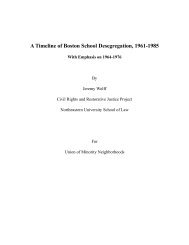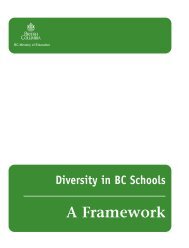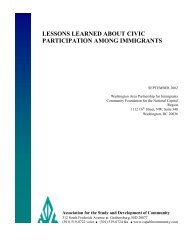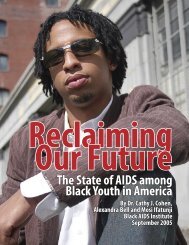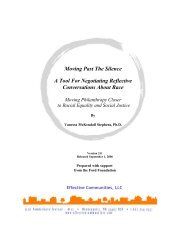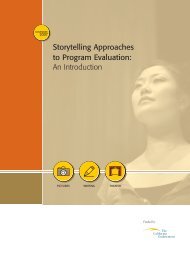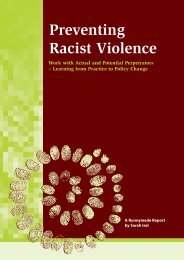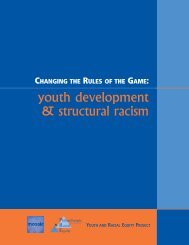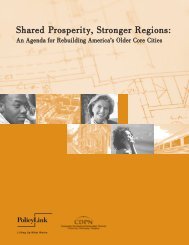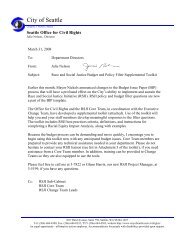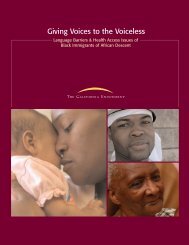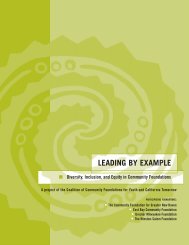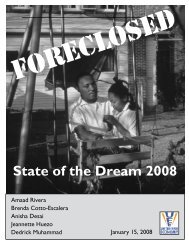Stories of Philanthropic Leadership in Advancing Regional and ...
Stories of Philanthropic Leadership in Advancing Regional and ...
Stories of Philanthropic Leadership in Advancing Regional and ...
You also want an ePaper? Increase the reach of your titles
YUMPU automatically turns print PDFs into web optimized ePapers that Google loves.
I. A. BUILDING POWER AND GIVINGVOICE TO COMMUNITYCONCERNS: COMMUNITYBENEFITS AGREEMENTSFoundations Highlighted:Ford FoundationThe New World FoundationUnitarian Universalist Veatch Program at Shelter Rock“When it comes to major developments, thepowerful <strong>and</strong> wealthy weigh <strong>in</strong>; but poor peoplehave no avenue to become engaged. CommunityBenefits Agreements create a voice to ga<strong>in</strong>measurable benefits.”— Carl Anthony, Ford FoundationWhen executed before development agreements aresigned with governmental <strong>of</strong>ficials, a CommunityBenefits Agreement (CBA) br<strong>in</strong>gs to thedecisionmak<strong>in</strong>g process vocal <strong>and</strong> visible communityadvocates <strong>in</strong>stead <strong>of</strong> adversaries. With a CBA, thecommunity to be impacted by a developmentproposal <strong>and</strong> the developers st<strong>and</strong> united beforegovernmental <strong>of</strong>ficials <strong>in</strong> support <strong>of</strong> major proposeddevelopments. This pr<strong>of</strong>ile demonstrates the benefits<strong>of</strong> CBAs, which provide the legal means for projectfunders to ensure that prosperity doesn’t go past thedoors <strong>of</strong> residents, but provides them with animproved quality <strong>of</strong> life.Project Pr<strong>of</strong>ileA Community Benefits Agreement, or CBA, is thelegally enforceable <strong>and</strong> negotiated result <strong>of</strong>agreements reached by community-basedorganizations <strong>and</strong> developers that <strong>of</strong>ten representw<strong>in</strong>-w<strong>in</strong> solutions for the community <strong>and</strong> thedeveloper. In CBA negotiations, a developer agrees toprovide specific <strong>and</strong> measurable community benefitsthat the community has a role <strong>in</strong> identify<strong>in</strong>g throughup-front dialogues. In return, residents <strong>and</strong>community-based organizations agree to support aproposed project when it comes before governmentalbodies entrusted with authority to make decisions onzon<strong>in</strong>g, <strong>in</strong>frastructure, or subsidies.In June 2004, the Ford Foundation convened aCommunity Benefits Roundtable, br<strong>in</strong>g<strong>in</strong>g togetherkey CBA leaders <strong>and</strong> public policy advocatesthroughout the country to share <strong>and</strong> learn from theircollective experiences. “Even with the best<strong>in</strong>tentions,” observes Carl Anthony, act<strong>in</strong>g director<strong>of</strong> the Ford Foundation’s Community <strong>and</strong> ResourceDevelopment Unit, “the table is unbalanced on largescaleprojects. When it comes to majordevelopments, the powerful <strong>and</strong> wealthy weigh <strong>in</strong>.But poor people have no avenue to become engaged.Community Benefits Agreements create a voice toga<strong>in</strong> measurable benefits.”“Without CBAs,” cont<strong>in</strong>ues Anthony, “elected<strong>of</strong>ficials are <strong>in</strong> a dilemma. The poor have no say <strong>and</strong>their quality <strong>of</strong> life goes down while that <strong>of</strong> theregion goes up. But with them, we create a voice <strong>and</strong>technical competence to ga<strong>in</strong> measurable benefits.”Add<strong>in</strong>g his support to CBAs, Chad Jones, programassociate for The New World Foundation’s PhoenixFund, declares, “This is a major area <strong>of</strong> activismbased on our belief that organizations <strong>of</strong> the work<strong>in</strong>gpoor should be led by leaders <strong>in</strong>digenous to theircommunities.”“We focus on two levels <strong>of</strong> democratic processes:democratic conditions <strong>and</strong> democratic practices,”expla<strong>in</strong>s Jones. “In the first area, we’re concernedwith racial <strong>and</strong> gender equality <strong>and</strong> leadershiptransmission. In thesecond area, we’reconcerned withstructures <strong>of</strong>accountability,<strong>in</strong>digenousleadership,participatoryplann<strong>in</strong>g, politicaladvocacy, <strong>and</strong>collaborative styles <strong>of</strong>work. The [CBA]process isparticipatory <strong>and</strong> soexp<strong>and</strong>s the pool <strong>of</strong> beneficiaries <strong>of</strong> economicredevelopment projects that are heavily subsidized.”“Without CBAs elected<strong>of</strong>ficials are <strong>in</strong> a dilemma.The poor have no say <strong>and</strong>their quality <strong>of</strong> life goesdown while that <strong>of</strong> the regiongoes up. But with them,we create a voice <strong>and</strong>technical competence toga<strong>in</strong> measurable benefits.”— Carl AnthonyThe follow<strong>in</strong>g examples highlight the capacity thatCBAs have to exert <strong>in</strong>fluence <strong>and</strong> forge <strong>in</strong>clusion <strong>in</strong>different locales, as demonstrated by the FigueroaCorridor Coalition for Economic Justice <strong>in</strong> LosAngeles, the Good Jobs <strong>and</strong> Livable NeighborhoodsCoalition <strong>in</strong> Milwaukee, Wis., <strong>and</strong> the Alliance forGood Jobs <strong>and</strong> Hous<strong>in</strong>g for Everyone <strong>in</strong> Seattle.EQUITABLE PUBLIC INVESTMENTPart III: Section 1: Promot<strong>in</strong>g Equitable Public Investment 18



